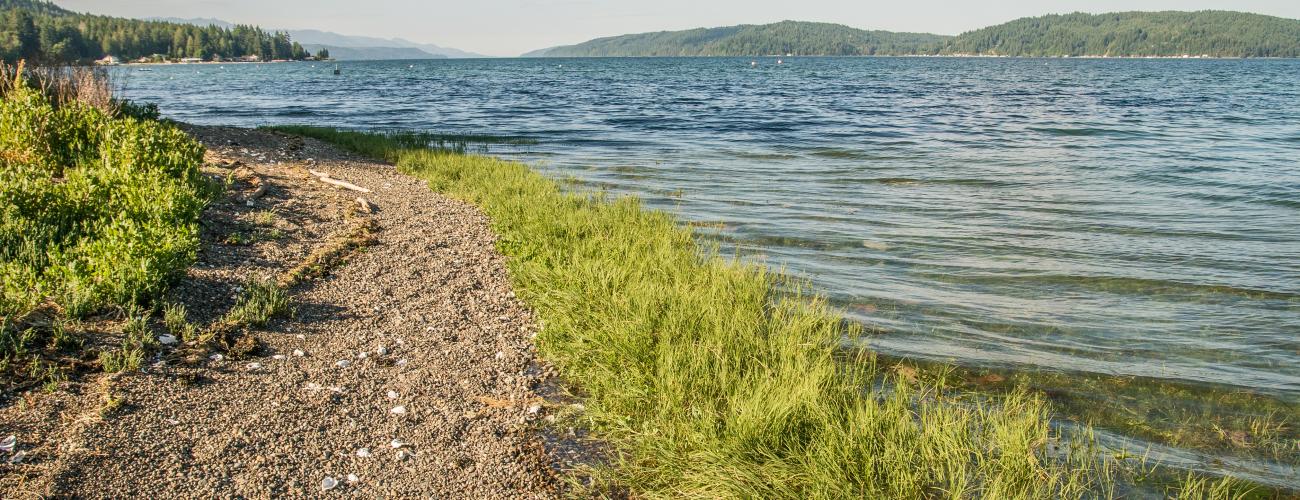Potlatch State Park History
Potlatch State Park is one of many of Washington’s state parks that was established in response to an appeal from local residents. In the building boom after the end of World War II, residents of the Hood Canal area felt squeezed out of access to the shoreline by rapidly spreading development.
The Great Bend
The park is located at the “Great Bend” of Hood Canal, just north of the extensive delta of the Skokomish River. Erosion of the Olympic Mountains to the west of Hood Canal, combined with the steep gradients of the river and its tributaries, carries a large quantity of sediment downriver. Silt, sand and gravel are deposited at the river mouth, creating an estuary rich with marine life at the Great Bend.
Indigenous Lands
Potlatch State Park lies within the traditional territories of Coast Salish Indigenous people whose present-day descendants include members of the Skokomish Indian Tribe. For thousands of years, Twana language-speaking people have lived by the shores of Hood Canal, traditionally wintering in villages and traveling during the summer to specific resource-rich areas for fishing, shellfishing, hunting and gathering.
Local tribes ceded ownership of much of their homelands to the US federal government under duress in the Treaty of Point No Point in 1855, keeping rights to harvest natural resources in their usual and accustomed places, including the lands and waters of Hood Canal. The treaty established the Skokomish Indian Reservation at the mouth of the Skokomish River, the winter home of the Skokomish Band of the Twana people. Other Twana people from throughout the Hood Canal region were required by the treaty to relocate to the reservation.
Anthropologist William W. Elmendorf noted that by the 1860s, many Indigenous people had relocated to the shoreline in the area of today’s Potlatch State Park, known as “Teba’das.” Prior to the treaty it had been used for thousands of years as a campsite in early spring for the harvest of herring.
The Skokomish Indian Reservation established by the treaty was enlarged to include Teba’das by President Ulysses S. Grant on February 25, 1874, after government surveys were completed in 1873.
In 1887, the US Congress passed the Dawes Act which created land allotments for tribal members on reservation lands and authorized the sale of other reservation lands to non-tribal people or corporations. In practice, the Dawes Act often resulted in much of the reservation lands passing into non-tribal ownership.
Robert Jackson, a tribal member, received an allotment that included the area of today’s Potlatch State Park. Allotments were held in trust by the US federal government for a number of years; the final patent was awarded to Jackson’s granddaughters, Jeanette Frink and Ellen Hanson, on January 24, 1910.
Ownership of today’s park land passed to descendants of Frink and Hanson, who developed the Minerva Resort and Mercantile business on the property by the 1930s after the Olympic Loop Highway was completed. Parts of the property were also leased to the Shoreline Log & Lumber Company which processed logs harvested in the local area from 1943 into the 1950s.
Tacoma City Light (now Tacoma Power) diverted the flow of the North Fork Skokomish River to a powerhouse located about a half mile north of today’s Potlatch State Park with the construction of Cushman Dam in 1926. Extensive timber harvest in the watershed of the Skokomish River on private and public lands compounded changes to the river’s sediment profile produced by the diversion of the North Fork. The result was frequent and intense flooding downstream on low-lying reservation lands.
Making a Park
In 1947, the Washington State Parks and Recreation Commission (WSPRC) received requests from the Hoodsport Commercial Club, Hood Canal Women’s Club and others urging establishment of a state park near Hoodsport for shoreline access to Hood Canal. The petitioners noted that private land ownership and residential and commercial development was choking off public access to the waterfront.
On July 18, 1960, the WSPRC purchased nearly 69 acres of the Minerva Resort from the Hanson family including tidelands, removed the resort buildings, and developed camping and day-use areas. On November 14, 1960, the WSPRC officially named Potlatch State Park, copying the name of the unincorporated community located about a mile north of the park. The community takes its name from the Potlatch Commercial and Terminal Company, which platted the townsite.
In 2007, a landmark agreement between the Skokomish Indian Tribe and the WSPRC returned dozens of acres of tidelands and 30 acres of park property to the Tribe. In exchange, the park expanded to the north to include more campsites.
Sharing the histories of Washington’s state parks is an ongoing project. Learn more here.

